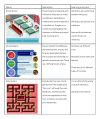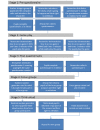Can Gaming Increase Antibiotic Awareness in Children? A Mixed-Methods Approach
- PMID: 28341618
- PMCID: PMC5384992
- DOI: 10.2196/games.6420
Can Gaming Increase Antibiotic Awareness in Children? A Mixed-Methods Approach
Abstract
Background: e-Bug is a pan-European educational resource for junior and senior school children, which contains activities covering prudent antibiotic use and the spread, treatment, and prevention of infection. Teaching resources for children aged 7-15 years are complemented by a student website that hosts games and interactive activities for the children to continue their learning at home.
Objective: The aim of this study was to appraise young people's opinions of 3 antibiotic games on the e-Bug student website, exploring children's views and suggestions for improvements, and analyzing change in their knowledge around the learning outcomes covered. The 3 games selected for evaluation all contained elements and learning outcomes relating to antibiotics, the correct use of antibiotics, and bacteria and viruses.
Methods: A mixed methodological approach was undertaken, wherein 153 pupils aged 9-11 years in primary schools and summer schools in the Bristol and Gloucestershire area completed a questionnaire with antibiotic and microbe questions, before and after playing 3 e-Bug games for a total of 15 minutes. The after questionnaire also contained open-ended and Likert scale questions. In addition, 6 focus groups with 48 students and think-aloud sessions with 4 students who had all played the games were performed.
Results: The questionnaire data showed a significant increase in knowledge for 2 out of 7 questions (P=.01 and P<.001), whereas all questions showed a small level of increase. The two areas of significant knowledge improvement focused around the use of antibiotics for bacterial versus viral infections and ensuring the course of antibiotics is completed. Qualitative data showed that the e-Bug game "Body Busters" was the most popular, closely followed by "Doctor Doctor," and "Microbe Mania" the least popular.
Conclusions: This study shows that 2 of the e-Bug antibiotic educational games are valuable. "Body Busters" effectively increased antibiotic knowledge in children and had the greatest flow and enjoyment. "Doctor Doctor" also resulted in increased knowledge, but was less enjoyable. "Microbe Mania" had neither flow nor knowledge gain and therefore needs much modification and review. The results from the qualitative part of this study will be very important to inform future modifications and improvements to the e-Bug games.
Keywords: antibiotic resistance; children; computer games; e-Bug; education.
©Alexander R Hale, Vicki Louise Young, Ann Grand, Cliodna Ann Miriam McNulty. Originally published in JMIR Serious Games (http://games.jmir.org), 24.03.2017.
Conflict of interest statement
Conflicts of Interest: None declared.
Figures
Similar articles
-
Young People's Knowledge of Antibiotics and Vaccinations and Increasing This Knowledge Through Gaming: Mixed-Methods Study Using e-Bug.JMIR Serious Games. 2019 Feb 1;7(1):e10915. doi: 10.2196/10915. JMIR Serious Games. 2019. PMID: 30707096 Free PMC article.
-
Computer games to teach hygiene: an evaluation of the e-Bug junior game.J Antimicrob Chemother. 2011 Jun;66 Suppl 5:v39-44. doi: 10.1093/jac/dkr122. J Antimicrob Chemother. 2011. PMID: 21680586
-
Overview of e-Bug: an antibiotic and hygiene educational resource for schools.J Antimicrob Chemother. 2011 Jun;66 Suppl 5:v3-12. doi: 10.1093/jac/dkr119. J Antimicrob Chemother. 2011. PMID: 21680584
-
The role of gaming for information, education and communication of AMR: full review of online education resources.JAC Antimicrob Resist. 2024 Jun 11;6(3):dlae080. doi: 10.1093/jacamr/dlae080. eCollection 2024 Jun. JAC Antimicrob Resist. 2024. PMID: 38863557 Free PMC article. Review.
-
Game on: The gamification of the pharmacy classroom.Curr Pharm Teach Learn. 2017 Jan-Feb;9(1):155-159. doi: 10.1016/j.cptl.2016.08.046. Epub 2016 Oct 26. Curr Pharm Teach Learn. 2017. PMID: 29180148 Review.
Cited by
-
Bacterial Survivor: An Interactive Game that Combats Misconceptions about Antibiotic Resistance.J Microbiol Biol Educ. 2018 Oct 31;19(3):19.3.101. doi: 10.1128/jmbe.v19i3.1675. eCollection 2018. J Microbiol Biol Educ. 2018. PMID: 30377473 Free PMC article. No abstract available.
-
Knowledge Assessment of E-Bug Assisted Antimicrobial Resistance Education Module in Class VII School Students of South Indian Coastal Town of Manipal.J Clin Med. 2019 Jan 12;8(1):84. doi: 10.3390/jcm8010084. J Clin Med. 2019. PMID: 30642058 Free PMC article.
-
Usability of Health Information Websites Designed for Adolescents: Systematic Review, Neurodevelopmental Model, and Design Brief.J Med Internet Res. 2019 Apr 23;21(4):e11584. doi: 10.2196/11584. J Med Internet Res. 2019. PMID: 31012856 Free PMC article.
-
Impact of the ´Alforja Educativa' on Ecuadorian schoolchildren's knowledge of bacteria, antibiotics, and antibiotic resistance, a pretest-posttest study.BMC Public Health. 2024 Mar 18;24(1):844. doi: 10.1186/s12889-024-18340-0. BMC Public Health. 2024. PMID: 38500082 Free PMC article.
-
Digital Marketing: A Unique Multidisciplinary Approach towards the Elimination of Viral Hepatitis.Pathogens. 2022 May 29;11(6):626. doi: 10.3390/pathogens11060626. Pathogens. 2022. PMID: 35745480 Free PMC article. Review.
References
-
- O'Neill J. The Review on Antimicrobial Resistance. 2016. [2016-07-26]. Tackling drug-resistant infections globally: final report and recommendations http://amr-review.org/
-
- Hawker JI, Smith S, Smith GE, Morbey R, Johnson AP, Fleming DM, Shallcross L, Hayward AC. Trends in antibiotic prescribing in primary care for clinical syndromes subject to national recommendations to reduce antibiotic resistance, UK 1995-2011: analysis of a large database of primary care consultations. J Antimicrob Chemother. 2014 Dec;69(12):3423–30. doi: 10.1093/jac/dku291. http://jac.oxfordjournals.org/cgi/pmidlookup?view=long&pmid=25091508 dku291 - DOI - PubMed
-
- Costelloe C, Metcalfe C, Lovering A, Mant D, Hay AD. Effect of antibiotic prescribing in primary care on antimicrobial resistance in individual patients: systematic review and meta-analysis. BMJ. 2010;340:c2096. http://www.bmj.com/cgi/pmidlookup?view=long&pmid=20483949 - PubMed
-
- World Health Organization WHO. 2014. Antimicrobial resistance: global report on surveillance http://www.who.int/drugresistance/documents/surveillancereport/en/
LinkOut - more resources
Full Text Sources
Other Literature Sources
Medical





